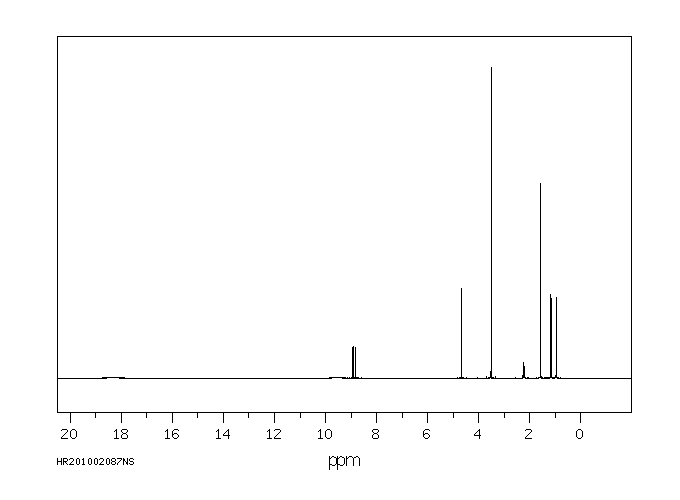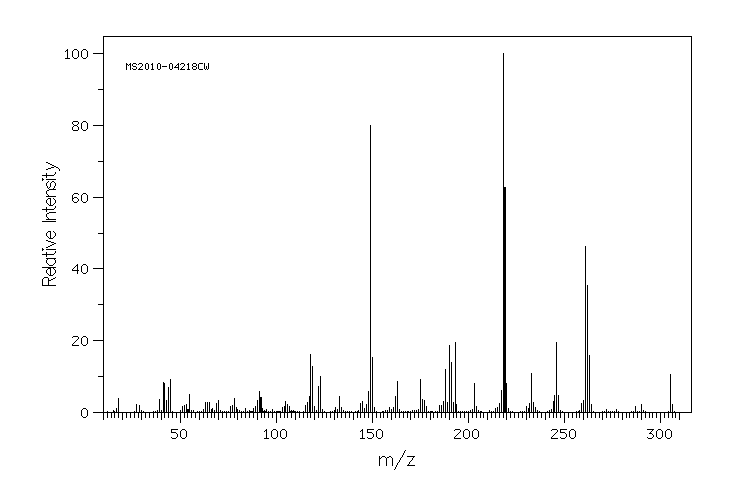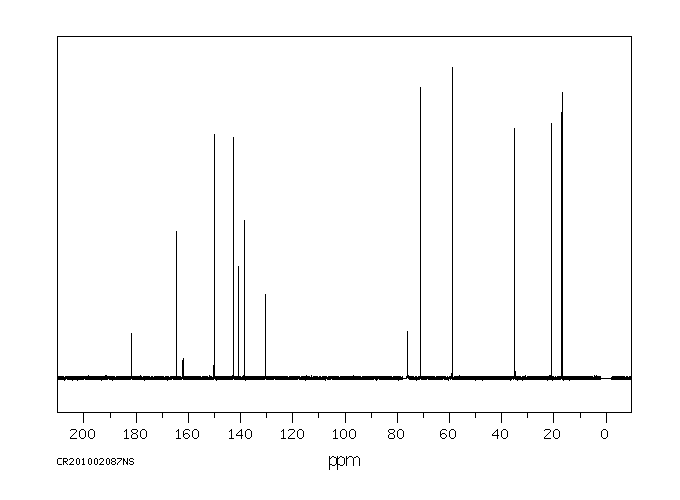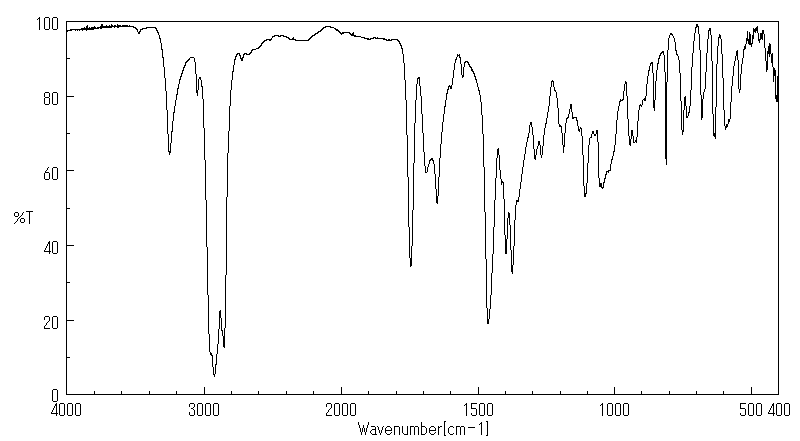甲氧咪草烟 | 114311-32-9
-
物化性质
-
计算性质
-
ADMET
-
安全信息
-
SDS
-
制备方法与用途
-
上下游信息
-
文献信息
-
表征谱图
-
同类化合物
-
相关功能分类
-
相关结构分类
物化性质
-
熔点:166-167°C
-
密度:1.39 g/cm3
-
溶解度:二甲基亚砜:20 mg/ml(65.50 mM)
-
颜色/状态:Off-white powdered solid
-
气味:Odorless
-
蒸汽压力:1.26X10-11 mm Hg at 25 °C (est)
-
稳定性/保质期:
在常温常压下保持稳定,应避免与强氧化剂接触。它对皮肤和眼睛没有刺激作用,并且通过动物实验未发现有致畸或致突变的特性。
-
腐蚀性:Product is not a corrosive hazard
-
解离常数:pKa1 = 2.3; pKa2 = 3.3
计算性质
-
辛醇/水分配系数(LogP):0.9
-
重原子数:22
-
可旋转键数:5
-
环数:2.0
-
sp3杂化的碳原子比例:0.466
-
拓扑面积:101
-
氢给体数:2
-
氢受体数:6
ADMET
安全信息
-
危险品标志:N
-
安全说明:S60,S61
-
危险类别码:R50/53
-
WGK Germany:3
-
危险品运输编号:UN3077 9/PG 3
SDS
制备方法与用途
后茬作物的安全性:甲氧咪草烟是一种咪唑咻酮类除草剂中的短残留品种,在施药后土壤中的药剂绝大部分在4个月内分解失效,因此对绝大多数后茬作物安全。但在混作、间种及复种时,则需考虑不同作物的敏感性和间隔时期:使用50 g(a.i.)/hm²剂量时,种植大麦、冬小麦和春小麦所需的间隔时间为4个月;种植玉米、水稻(不含苗床)、棉花、谷子、向日葵、烟草、马铃薯和西瓜所需间隔时间则为12个月;种植油菜和甜菜需间隔18个月。
毒性甲氧咪草烟的工业品对大鼠和小鼠急性经口LD₅₀大于5000 mg/kg,对兔急性经皮LD₅₀大于4000 mg/kg。对皮肤和眼睛无刺激性,并且动物试验未显示致畸、致突变作用。鹌鹑急性经口LD₅₀超过1846 mg/kg,虹鳟鱼LC₅₀为122 mg/L(96小时)。由于其对哺乳动物的毒性极低,因此在使用和储存时非常安全。
生物活性Imazamox 是一种全身性除草剂,具有高选择性、高活性及广谱活性。它通过抑制植物中的乙酰乳酸合酶(ALS)来阻碍植物生长并最终导致死亡。
体外研究在土壤中,Imazamox 的半衰期为1至3个月,显示其对哺乳动物毒性很低。用250 μM Imazamox 处理植物7天后,在紫云英中的积累量是豌豆的6倍以上。
体内研究通过腹腔注射给予12-36 mg/kg 的Imazamox(持续24至72小时),对雄性Sprague-Dawley大鼠肝和胰腺产生毒性作用。最高剂量组在肝细胞中观察到损伤,且影响DNA合成及细胞分裂和生长。
用途甲氧咪草烟是一种广谱、高活性的咪唑啉酮类除草剂。主要通过抑制乙酸羟酸合成酶(AHAs)的活性来干扰缬氨酸、亮氨酸与异亮氨酸的生物合成,从而破坏蛋白质的合成并影响DNA合成及细胞分裂和生长。
这种药剂在苗后茎叶处理后可被植物叶片迅速吸收,并传导至全株。杂草会在4至6周内死亡。对大多数豆科作物具有高度耐药性,尤其适合大豆地苗后早期茎叶喷雾,在杂草1至4叶期施用效果最佳。对某些敏感杂草(如苋、苍耳等)于4叶期喷药也能收到良好防效。
在大豆田中,每公顷的用药量为35~45 g有效成分,喷洒时应加入0.1%~0.25%非离子型表面活性剂或1.0%~1.25%浓缩植物油。另外,加入1.0%~2.0%氮肥或每公顷2~4 kg硫酸铵亦能提高药物的生物活性。主要杀草谱为大多数阔叶杂草,并对稗、野燕麦、狗尾草、看麦娘等禾本科杂草有良好的防效。
生产方法制备甲氧咪草烟的方法之一是从丙醛出发,通过与甲醛缩合、闭环、卤化及甲氧基化等一系列反应合成。另一种方法则是以甲氧基丙醛、草酸二乙酯和甲基异丙基酮为原料,经过一系列反应来生产甲氧咪草烟。
以上为甲氧咪草烟的详细说明。
上下游信息
反应信息
-
作为反应物:参考文献:名称:咪唑啉酮除草剂的二甲基衍生物的合成:它们在测定这些除草剂的有效气相色谱方法中的用途。摘要:吡虫啉,吡虫啉,咪唑并吡咯,咪唑并吡咯,2- [4,5二氢-1、4-二甲基-4-(1-甲基乙基)-5-氧代-1H-咪唑-2-基] -5-甲氧基甲基的二甲基衍生物-3-吡啶羧酸,2- [4,5-二氢-1,4-二甲基-4-(1-甲基乙基)-5-氧代-1H-咪唑-2-基] -4-甲基苯甲酸,和制备2- [4,5-二氢-1,4-二甲基-4-(1-甲基乙基)-5-氧代-1H-咪唑-2-基] -5-甲基苯甲酸并充分表征。这些衍生物的可利用性已导致开发用于在水,大豆和土壤等基质中对咪唑啉酮类除草剂进行痕量分析的高效多残留气相色谱方法。DOI:10.1021/jf000428h
-
作为产物:描述:diethyl 5-(methoxymethyl)pyridine-2,3-dicarboxylate 在 4-甲基吡啶 、 双氧水 、 乙酸酐 、 sodium hydroxide 作用下, 以 5,5-dimethyl-1,3-cyclohexadiene 、 戊醇 、 水 为溶剂, 反应 7.0h, 生成 甲氧咪草烟参考文献:名称:一种咪唑啉酮化合物的制备方法摘要:本发明提供一种咪唑啉酮化合物的制备方法,属于有机合成技术领域,其可解决现有的制备咪唑啉酮类化合物的过程中产生大量废水,产品中杂质含量较高的问题。本发明的咪唑啉酮化合物的制备方法使用碳酸铵合成5‑烷基吡啶‑2,3‑二甲酸酯的溶液,在后处理时避免加入水、萃取、精制等步骤;得到的5‑烷基吡啶‑2,3‑二甲酸酯的溶液用于后续反应,不产生废水。之后制备5‑烷基吡啶‑2,3‑二甲酸酐的过程中加入了催化剂,并在后续反应过程中控制pH,这样可以避免杂质的产生,提高产品纯度。本发明的方法制备的咪唑啉酮化合物可作为高效除草剂使用。公开号:CN109467548A
文献信息
-
[EN] ACC INHIBITORS AND USES THEREOF<br/>[FR] INHIBITEURS DE L'ACC ET UTILISATIONS ASSOCIÉES
-
[EN] 3-[(HYDRAZONO)METHYL]-N-(TETRAZOL-5-YL)-BENZAMIDE AND 3-[(HYDRAZONO)METHYL]-N-(1,3,4-OXADIAZOL-2-YL)-BENZAMIDE DERIVATIVES AS HERBICIDES<br/>[FR] DÉRIVÉS DE 3-[(HYDRAZONO))MÉTHYL]-N-(TÉTRAZOL-5-YL)-BENZAMIDE ET DE 3-[(HYDRAZONO)MÉTHYL]-N-(1,3,4-OXADIAZOL-2-YL)-BENZAMIDE UTILISÉS EN TANT QU'HERBICIDES申请人:SYNGENTA CROP PROTECTION AG公开号:WO2021013969A1公开(公告)日:2021-01-28The present invention related to compounds of Formula (I): or an agronomically acceptable salt thereof, wherein Q, R2, R3, R4, R5 and R6 are as described herein. The invention further relates to compositions comprising said compounds, to methods of controlling weeds using said compositions, and to the use of compounds of Formula (I) as a herbicide.本发明涉及以下式(I)的化合物或其农业上可接受的盐,其中Q、R2、R3、R4、R5和R6如本文所述。该发明还涉及包含所述化合物的组合物,使用这些组合物控制杂草的方法,以及将式(I)的化合物用作除草剂的用途。
-
[EN] BICYCLYL-SUBSTITUTED ISOTHIAZOLINE COMPOUNDS<br/>[FR] COMPOSÉS ISOTHIAZOLINE SUBSTITUÉS PAR UN BICYCLYLE申请人:BASF SE公开号:WO2014206910A1公开(公告)日:2014-12-31The present invention relates to bicyclyl-substituted isothiazoline compounds of formula (I) wherein the variables are as defined in the claims and description. The compounds are useful for combating or controlling invertebrate pests, in particular arthropod pests and nematodes. The invention also relates to a method for controlling invertebrate pests by using these compounds and to plant propagation material and to an agricultural and a veterinary composition comprising said compounds.本发明涉及公式(I)中变量如索权和说明中所定义的自行车基取代异噻唑啉化合物。这些化合物对抗或控制无脊椎动物害虫,特别是节肢动物害虫和线虫方面具有用途。该发明还涉及一种通过使用这些化合物来控制无脊椎动物害虫的方法,以及包含所述化合物的植物繁殖材料、农业和兽医组合物。
-
[EN] AZOLINE COMPOUNDS<br/>[FR] COMPOSÉS AZOLINE申请人:BASF SE公开号:WO2015128358A1公开(公告)日:2015-09-03The present invention relates to azoline compounds of formula (I) wherein A, B1, B2, B3, G1, G2, X1, R1, R3a, R3b, Rg1 and Rg2 are as defined in the claims and the description. The compounds are useful for combating or controlling invertebrate pests, in particular arthropod pests and nematodes. The invention also relates to a method for controlling invertebrate pests by using these compounds and to plant propagation material and to an agricultural and a veterinary composition comprising said compounds.本发明涉及式(I)的噁唑啉化合物,其中A、B1、B2、B3、G1、G2、X1、R1、R3a、R3b、Rg1和Rg2如权利要求和描述中所定义。这些化合物对抗或控制无脊椎动物害虫,特别是节肢动物害虫和线虫方面具有用途。该发明还涉及一种利用这些化合物控制无脊椎动物害虫的方法,以及包括所述化合物的植物繁殖材料、农业和兽医组合物。
-
[EN] MICROBIOCIDAL OXADIAZOLE DERIVATIVES<br/>[FR] DÉRIVÉS D'OXADIAZOLE MICROBIOCIDES申请人:SYNGENTA PARTICIPATIONS AG公开号:WO2017157962A1公开(公告)日:2017-09-21Compounds of the formula (I) wherein the substituents are as defined in claim 1, useful as a pesticides, especially fungicides.式(I)的化合物,其中取代基如权利要求1所定义,作为杀虫剂特别是杀菌剂有用。
表征谱图
-
氢谱1HNMR
-
质谱MS
-
碳谱13CNMR
-
红外IR
-
拉曼Raman
-
峰位数据
-
峰位匹配
-
表征信息










